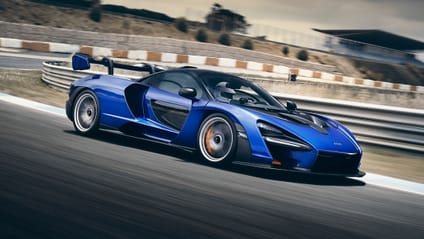
Good stuff
The brakes, the grip, the aero, the lack of compromise, the attention to detail
Bad stuff
Engine isn’t the most charismatic, no luggage space. At all
Overview
What is it?
McLaren claims this is the most extreme road car it’s ever built. That’s kind of what you’d hope given who it’s decided to name it after, and what they’ve decided to make it look like. Needless to say, aesthetic design did not lead the way. The Senna is governed by aerodynamics - up to 800kg of air pressing the mid-engined two-seater into the tarmac at 155mph. It could produce more, but above that speed McLaren alter the wing angles to maximise acceleration.
Clearly, there’s a lot going on here. Not least that vast rear wing, able to swing through almost 90 degrees, and hidden winglets in the nose that work in harmony with it. This is a car that plays with the air, makes it work for the car as it passes over the bodywork.
The Senna is the next step in McLaren’s Ultimate Series range, sitting above the Super Series (720S) and Sport Series (540 and 570) models. It’s not a replacement for the P1, but instead is designed to set new standards in a particular direction - in this case, track performance.
It is road legal - quite an achievement when you think about pedestrian safety and getting a car with this many slats, wings and holes in its bodywork through the legislative process. It’s built around a central carbon tub made up of 170 separate pieces and powered by the familiar 4.0-litre twin turbo V8 from the 720S. For this application the engine has a new camshaft, new pistons, intake manifold, and an Inconel and titanium exhaust. It develops 789bhp and 590lb ft, powering the rear wheels through a seven-speed twin clutch gearbox. The sprints to 62mph and 124mph are taken care of in 2.8 and 6.8secs respectively and top speed is 208mph. Not that top speed matters here - the Senna, as you would hope, has a single-minded focus on lap times.
And it’s weight, not power, that has clearly dominated the engineers' thought processes. The 4.87kg rear wing is able to support up to 100 times its own weight, each front wing weighs a mere 660 grams, even the door mechanisms have been changed - mechanical releases giving way to electrical, reducing weight by 20 per cent. All told, the Senna weighs just 1,198kg dry, so around 1,300kg with all fluids and fuel.
500 cars, each costing from £750,000, will be built over the next year. All have already been spoken for.
Our choice from the range

What's the verdict?
Calling a car the Senna is tricky – you open yourself up to accusations that you’re trying to cash in on a memory and face the risk that you create a car that can never live up to the might of the man. I don’t think McLaren is doing the former, and I think it’s come very close to succeeding with the latter. This is the exact sort of car that suits the name – one aimed purely at lap speed, possessing incredible focus.
And as with the way it looks, it drives unconventionally too – it doesn’t dance and play, but instead uses the air and suspension to lock itself to the surface. Is it actually fun to drive? It’s more grown up than that, more steely and determined.
You come away staggered by its abilities, wanting another chance to try to find the actual braking points, to feel again the other-worldly grip and stability as it turns in, to once again pore over the bodywork and try to work out why it looks like it does, to be that fleshy weak link in the chain. I could see how it could become addictive, how every other car in an owner’s collection would suddenly feel slightly inadequate on track. In short it’s a stunning achievement.
Trending this week
- Car Review
BMW iX3







